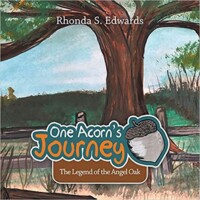Title: One Acorn’s Journey
Subtitle: The Legend of the Angel Oak
Author: Rhonda S. Edwards
Illustrated by: Wendy S. Tyree
Publisher: iUniverse
ISBN: 978-1-6632-2721-8
Genre: Illustrated Children’s Book / Nature / Education
Pages: 34
Reviewed by: Beth Adams
Pacific Book Review
 There is a well-know expression about children resembling their parents by the phrase: “The acorn falls close to the oak.” However, in One Acorn’s Journey: The Legend of the Angel Oak, author Rhonda S. Edwards brings readers on an adventure of the renewal of life with a personified acorn falling from the beak of a seagull, being picked up by a native Indian girl, planted in a special spot, and growing over the centuries into a magnificent oak tree – in real life being the largest specimen in North America.
There is a well-know expression about children resembling their parents by the phrase: “The acorn falls close to the oak.” However, in One Acorn’s Journey: The Legend of the Angel Oak, author Rhonda S. Edwards brings readers on an adventure of the renewal of life with a personified acorn falling from the beak of a seagull, being picked up by a native Indian girl, planted in a special spot, and growing over the centuries into a magnificent oak tree – in real life being the largest specimen in North America.
This book is captivating from the very start. It tells the journey of an acorn, close to being eaten by a bird yet surviving to be later found by Hatokwassi, a young Kiawah native girl when gathering food by the seashore. Hatokwassi places the acorn in a pouch made from raccoon hide which had the sweet aroma of peppermint; that is when and where the acorn found safety and warmth.
Hatokwassi says this blessing when planting the acorn by her village’s garden: “Strong spirit of the acorn, I accept you as a gift for my village. Your bountiful branches will shade the garden from sun that is too hot, your strong boughs will provide safe arms for the playing of our children, and your plentiful seeds will provide food for the squirrels. May Kiawah, animal, and tree live in harmony. I pray for you to grow and become a mighty oak tree.”
Over the centuries, the oak became a source of food for squirrels, shelter for birds, and shade to the dwellers beneath, as the culture and people of the Kiawah Indians changed to the early settlers of North America then onto the Americans inhabiting South Carolina. The only threat to the existence of this magnificent tree came from humans wanting to cut it down to make room for housing, yet the author tells the factual history of the tree and its surroundings being saved by a land trust.
The wonderful illustrations by artist Wendy S. Tyree, which we learn is the sister to the author, brings this storybook to life with the elements of a near-death adventure of the acorn, to the survival and rescue by the Indian girl, to the feelings of sprouting in its new planting area, to becoming the most magnificent tree of its kind. These images are fanciful yet realistic, providing a visual sequence which will imbed itself in all readers’ minds; children and adults alike.
When reading this, I was impressed with the vernacular of the author, using mature and impressive words and sentences. The narrative does not “talk down” to children, but rather elevates the readers’ vocabulary by having the meanings of expressions perceived within the storyline itself. Yet, to emphasize these words, Rhonda S. Edwards has a quite extensive glossary at the end of the book, along with suggestions on further educating children after reading this book.
All in all, One Acorn’s Journey: The Legend of the Angel Oak, is a Best-In-Class book; one which will stand tall and strong like an oak tree in the crowded genre of illustrated children’s books. Filled with the inherent will to survive and thrive, this acorn was at the mercy of animals and elements beyond its control, to ultimately becoming a historical landmark of today’s civilization. This is a must-have book for all family libraries!


